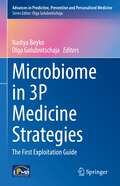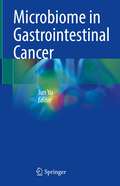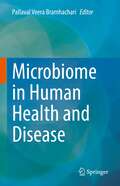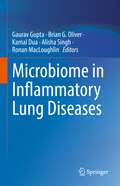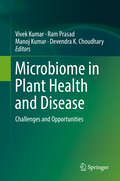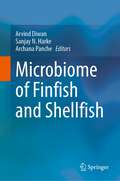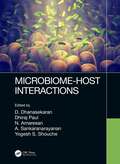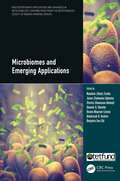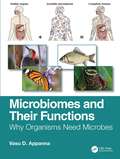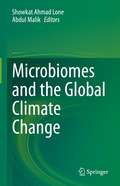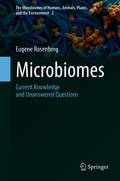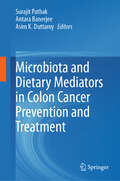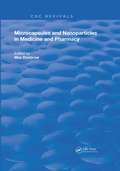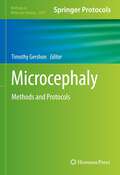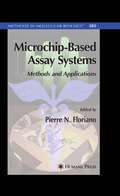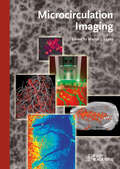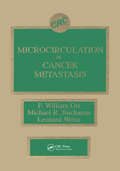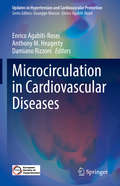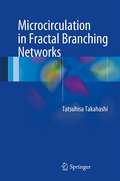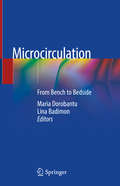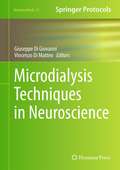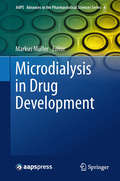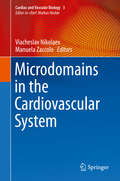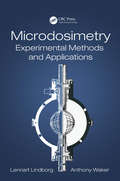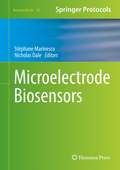- Table View
- List View
Microbiome in 3P Medicine Strategies: The First Exploitation Guide (Advances in Predictive, Preventive and Personalised Medicine #16)
by Olga Golubnitschaja Nadiya BoykoThe book analyses microbiome-relevant findings focused on clinical needs providing the roadmap to implement recent achievements in the area representing a valuable contribution to the paradigm shift from reactive to predictive, preventive and personalised medicine (PPPM / 3PM) considered as the most advanced concept in medicine. Already well-acknowledged as well as future advantages of application of pre-, pro- and pharma-biotics are detailed in the book. Socio-economic impacts of the area are considered in the context of the entire spectrum of healthcare services from disease care provided to patients up to health care provided to persons in suboptimal health conditions. Innovative technologies including phenotyping, genotyping, individualised profiling, patient stratification, big data analysis, and multi-omics, amongst others are all involved in the book. The book is unique from view point of multi-professional expertise involved. International network presents more than 10 countries worldwide including Belgium, China, Germany, Israel, Ukraine and USA. The data presented are of great scientific value and of particular importance for educating a broad spectrum of professionals including researchers, healthcare givers, policy makers, business people, policy makers and general population.
Microbiome in Gastrointestinal Cancer
by Jun YuThis book covers state-of-the-art topics covering evidences indicate that the gut microbiota can be harnessed for cancer prevention as well as to modulate the efficacy of chemotherapy and immunotherapy. This book includes: 1) characterization of the dysregulated microbiome in gastrointestinal cancers (Chapters 1-6); 2) the molecular mechanism of action of gut microbiota via microbial metabolites and direct interaction with host cancer or immune cells (Chapters 7-11); 3) key methodologies for studying the role of gut microbiota in cancers (Chapters 12-13); and 4) the potential application of gut microbes for the prevention and treatment of gastrointestinal cancers (Chapters 14-17). The contributors are international experts in molecular and cellular biology, microbiology, metabolomics, bioinformatics and physician scientists to provide in-depth reviews of this subject. This book provides a rich resource of information on this important topic for graduate students, basic researchers and physicians.
Microbiome in Human Health and Disease
by Pallaval Veera BramhachariThe book provides an overview on how the microbiome contributes to human health and disease. The microbiome has also become a burgeoning field of research in medicine, agriculture & environment. The readers will obtain profound knowledge on the connection between intestinal microbiota and immune defense systems, medicine, agriculture & environment. The book may address several researchers, clinicians and scholars working in biomedicine, microbiology and immunology. The application of new technologies has no doubt revolutionized the research initiatives providing new insights into the dynamics of these complex microbial communities and their role in medicine, agriculture & environment shall be more emphasized. Drawing on broad range concepts of disciplines and model systems, this book primarily provides a conceptual framework for understanding these human-microbe, animal-microbe & plant-microbe, interactions while shedding critical light on the scientific challenges that lie ahead. Furthermore this book explains why microbiome research demands a creative and interdisciplinary thinking—the capacity to combine microbiology with human, animal and plant physiology, ecological theory with immunology, and evolutionary perspectives with metabolic science.This book provides an accessible and authoritative guide to the fundamental principles of microbiome science, an exciting and fast-emerging new discipline that is reshaping many aspects of the life sciences. These microbial partners can also drive ecologically important traits, from thermal tolerance to diet in a typical immune system, and have contributed to animal and plant diversification over long evolutionary timescales. Also this book explains why microbiome research presents a more complete picture of the biology of humans and other animals, and how it can deliver novel therapies for human health and new strategies.
Microbiome in Inflammatory Lung Diseases
by Gaurav Gupta Kamal Dua Brian G. Oliver Alisha Singh Ronan MacLoughlinThis book reviews the role of the lung microbiome in the development and progression of lung diseases. It deals with the role of microbiota dysbiosis in influencing host defense and immunity leading to resistance, colonization, and disease exacerbation. The book delineates the complex interaction between pathogen and lung residual microbiota during disease conditions. It further highlights the potential role of lung microbiota as the key modulator of lung carcinogenesis and immune response against cancer cells. Lastly, it reviews technological developments for unraveling the lung microbiome that profoundly impacts clinical diagnostics. This book is an essential resource for the scientists working in pulmonary diseases, pharmaceutical & clinical sciences, and pulmonary clinicians.
Microbiome in Plant Health and Disease: Challenges and Opportunities
by Manoj Kumar Devendra K. Choudhary Ram Prasad Vivek KumarThe book discusses the complex interactions between plants and their associated microbial communities. It also elucidates the ways in which these microbiomes are connected with the plant system, and how they affect plant health. The different chapters describe how microbiomes affect plants with regard to immunity, disease conditions, stress management and productivity. In addition, the book describes how an ‘additional plant genome’ functions as a whole organ system of the host, and how it presents both challenges and opportunities for the plant system. Moreover, the book includes a dedicated section on using omics tools to understand these interactions, and on exploiting them to their full potential.
Microbiome of Finfish and Shellfish
by Arvind Diwan Sanjay N. Harke Archana PancheThis book helps us to understand the importance of the microbiome associated with finfish and shellfish inhabiting different locations and varied environmental and biological situations. It covers modern molecular tools for identifying microbiome composition and their precise identification at the species level. The book also covers the molecular structural composition of individual microbes, metabolite resources from microbiome species, their functional properties, and production aspects. Notable, the book covers the microbiome applications in the gut systems of finfish and shellfish to the digestion, nutrition, growth, reproduction, immune system, and vulnerability of the host to diseases. It also reviews diversity and functional properties, relationships with diseases, health status, data on species-specific metagenomics, and probiotic research. It highlights the relevance of microbial communities for the development of new and innovative bio-products to build bio and pharmaceutical industries, including aquaculture. This book is an invaluable source for researchers and professionals involved in fishery science, fisheries and aquaculture, fish biotechnology, and fish microbiology and pathology
Microbiome-Host Interactions
by Dhiraj Paul A. Sankaranarayanan N. Amaresan D. Dhanasekaran Yogesh S. ShoucheMicrobiota are a promising and fascinating subject in biology because they integrate the microbial communities in humans, animals, plants, and the environment. In humans, microbiota are associated with the gut, skin, and genital, oral, and respiratory organs. The plant microbial community is referred to as "holobiont," and it is influential in the maintenance and health of plants, which themselves play a role in animal health and the environment. The contents of Microbiome-Host Interactions cover all areas as well as new research trends in the fields of plant, animal, human, and environmental microbiome interactions. The book covers microbiota in polar soil environments, in health and disease, in Caenorhabditis elegans, and in agroecosystems, as well as in rice root and actinorhizal root nodules, speleothems, and marine shallow-water hydrothermal vents. Moreover, this book provides comprehensive accounts of advanced next-generation DNA sequencing, metagenomic techniques, high-throughput 16S rRNA sequencing, and understanding nucleic acid sequence data from fungal, algal, viral, bacterial, cyanobacterial, actinobacterial, and archaeal communities using QIIME software (Quantitative Insights into Microbial Ecology). FEATURES Summarizes recent insight in microbiota and host interactions in distinct habitats, including Antarctic, hydrothermal vents, speleothems, oral, skin, gut, feces, reproductive tract, soil, root, root nodules, forests, and mangroves Illustrates the high-throughput amplicon sequencing, computational techniques involved in the microbiota analysis, downstream analysis and visualization, and multivariate analysis commonly used for microbiome analysis Describes probiotics and prebiotics in the composition of the gut microbiota, skin microbiome impact in dermatologic disease prevention, and microbial communities in the reproductive tract of humans and animals Presents information in a reachable way for students, teachers, researchers, microbiologists, computational biologists, and other professionals who are interested in strengthening or enlarging their knowledge about microbiome analysis with next-generation DNA sequencing in the different branches of the sciences
Microbiomes and Emerging Applications (Multidisciplinary Applications and Advances in Biotechnology)
by Nwadiuto Diuto EsiobuThis book covers a range of important topics and recent advances in metagenomics, microbiomes and their emerging applications, including microbiota transplantation and its health implications. It also discusses microbiome composition and development in humans. The contributors of this volume provide detailed information on prebiotics and probiotics for enhanced human health. They also introduce microbiomes as the next frontiers in medicine, agriculture, industry and environment. A chapter is presented that discusses probiotic research studies in Nigeria and Canada that led to the discovery of Lactobacillus pentosus KCA1. The book contains timely knowledge and will be useful reference material for scientists and researchers working in the fields of food and agricultural biotechnology, biopharmaceuticals and medical biotechnology, fermentation technology, environmental biotechnology, microbiomes and microbial biotechnology and health care. Emphasizes recent advances in metagenomics and microbiomes and their emerging applications in medicine, agriculture, industry and environment Provides detailed information on prebiotics and probiotics for enhanced human health Introduces microbiomes as the next frontiers in medicine, agriculture, industry and environment Reviews microbiota transplantation, health implications and the way forward Discusses microbiome-epigenetic-host interactions essential for the physiological functions of the body in health and disease Nwadiuto (Diuto) Esiobu, Ph.D., is a Professor of Microbiology and Biotechnology at Florida Atlantic University, Boca Raton, FL, USA, and the President and Founder, of Applied Biotech Inc. and ABINL. James Chukwuma Ogbonna, Ph.D., is a Professor of Microbiology and Biotechnology, and Director, National Biotechnology Development Agency, South East Zonal Biotechnology Centre, University of Nigeria, Nsukka, Nigeria. Charles Oluwaseun Adetunji, Ph.D., is an Associate Professor of Microbiology and Biotechnology, and Director of Intellectual Property and Technology Transfer, Edo State University Uzairue, Nigeria. Olawole O. Obembe, Ph.D., is a Professor of Plant Biotechnology and UNESCO Chair, Plant Biotechnology, Covenant University, Ota, Nigeria. Ifeoma Maureen Ezeonu, Ph.D., is a Professor of Medical Microbiology and Molecular Genetics in the Department of Microbiology, University of Nigeria, Nsukka, Nigeria. Abdulrazak B. Ibrahim, Ph.D., is a Capacity Development Expert at the Forum for Agricultural Research in Africa (FARA) and Associate Professor of Biochemistry, Ahmadu Bello University, Zaria, Nigeria. Benjamin Ewa Ubi, Ph.D., is a Professor of Plant Breeding and Biotechnology and Director, Biotechnology Research and Development Centre, Ebonyi State University, Abakaliki, Nigeria..
Microbiomes and Their Functions: Why Organisms Need Microbes
by Vasu D. AppannaThis book provides a fundamental understanding of the importance of the microbiome in the life of virtually all multicellular organisms. It explains why microbes are an integral part of living organisms and describes the diverse roles they perform for their hosts. Although the significance of modified bacteria such as the mitochondrion and chloroplast is deeply rooted in the evolution of all complex organisms, it is only recently that the contribution of microbial partners within and on their hosts is becoming fully evident. These communities of microbes are as essential to organisms as are the visible organs. Microbiomes are indeed “invisible organs.” They participate in the digestive process, assist in communication networks, supply essential nutrients, guard against foreign intrusion, promote development and contribute to well-being. This unique approach, where the dependence of the hosts on their microbiomes is explained, will be a must-read for undergraduate and graduate students. Researchers and professionals probing microbial interactions with living organisms will find this book interesting and enriching. Key Features · Emphasizes the roles microbiomes play within their hosts. · Includes many captivating illustrations enabling easy comprehension. · Explains microbiome functions from algae to vertebrates. · Reveals how microbiomes contribute to the health of the hosts and the ecosystems. · Describes the impact of dysbiosis on diseases, food security and climate change. · Boxed sections provide a detailed analysis of concepts and are accompanied by vivid illustrations.
Microbiomes and the Global Climate Change
by Abdul Malik Showkat Ahmad LoneThis book covers the contemporary environmental issues faced by life on the planet and the role planetary microbiomes play in such issues. Providing insights on the net favorable and adverse effect of microbial processes, this volume covers both the spontaneous and anthropocentric events that impact climate change and life on the planet. The book describes the ecological significance of microbiomes associated with the kingdoms Plantae and Animalia with respect to climate change, natural and anthropogenic causes of climate change, microbial interactions in nature, planetary microbiomes and food security, climate change in relation to disease epidemiology and human health and engineering microorganisms to mitigate the consequences of climate change. The individual chapters in the intended book provide both theoretical and practical exposure to the current issues and future challenges of climate change in relation to the microbiomes. This collection should serve as ready reference to the researchers working in the area to reshape their future research in addressing the challenges of global climate change.
Microbiomes: Current Knowledge and Unanswered Questions (The Microbiomes of Humans, Animals, Plants, and the Environment #2)
by Eugene RosenbergThis book examines an important paradigm shift in biology: Plants and animals, traditionally viewed as individuals, are now considered to be complex systems and host to a plethora of microorganisms. After first presenting historical aspects of microbiota research, bacterial compositions of individual microbiomes and the critical analysis of current methods, the book discusses how microbial communities inside the human body are profoundly affected by numerous factors, such as macro- and micro-nutrients, physical exercise, antibiotics, gender and age. As described by current research, the author highlights how microbiomes contribute to the fitness of the host by providing nutrients, inhibiting pathogens, aiding in the storage of fat during pregnancy, and contributing to development and behavior. The author not only focusses on prokaryotic components in microbiomes, but also addresses single-cell eukaryotes and viruses. This follow-up to the successful book The Hologenome Concept: Human, Animal and Plant Microbiota, published in 2013, provides a contemporary overview of microbiomes. It appeals to anyone working in the life sciences and biomedicine.
Microbiota and Dietary Mediators in Colon Cancer Prevention and Treatment
by Asim K. Duttaroy Surajit Pathak Antara BanerjeeThe book discusses the role of gut microbiome composition in colorectal cancer progression, linking intestinal inflammation, tumorigenesis and anti-cancer immune responses. Chapters delve into various areas, including the mechanisms of action of probiotics and prebiotics (such as Lactobacillus and Bifidobacterium strains, and fructans and galactans, respectively), functional foods such as α-carotene, β-carotene, lutein, β-cryptoxanthin, fucoxanthin, isothiocyanates, flavonoids, probiotics, fibre and omega-3. Lycopene, β-cryptoxanthin, and fucoxanthin. Dietary phytochemicals such as polyphenols (curcumin, gingerol, ferulic acid (FA) and hydroxytyrosol); alkaloids (piperine, and protopine); terpenoids (artemisinin, and astaxanthin); iridoid glycoside (picroside II, and morroniside); and flavonoid (quercetin) on cancer, immune responses, and the gut microbiome. It examines the interaction and influence of prebiotics and probiotics in colorectal cancer treatment, their use in managing chemotherapy-related gastrointestinal problems, and their potential as adjuvants. The book also investigates how these gut microbes are associated with tumor progression and anti-cancer treatment efficacy. This knowledge can be used to develop biomarkers that predict immunotherapy effectiveness and improve treatment outcomes through modulation. This book provides a comprehensive update on the latest research and clinical applications in the field, offering valuable insights into the complex interplay between probiotics, the gut microbiome, and colorectal cancer. It serves as an invaluable resource for healthcare professionals, researchers, and students seeking to understand this dynamic area of study.
Microcapsules and Nanoparticles in Medicine and Pharmacy (Routledge Revivals)
by D. Sc. Max DonbrowFirst published in 1992: This book provides a comprehensive look at the design and production of microcapsules, microspheres, and nanoparticles. It discusses the diverse aspects and skills that must be mastered to prepare and test products that will work correctly and be clinically acceptable for human or animal use.
Microcephaly: Methods and Protocols (Methods in Molecular Biology #2583)
by Timothy GershonThis volume discusses the latest imaging and molecular techniques for studying microcephaly through neural progenitor proliferation, survival, and gene expression. All of the methods covered in this book use the mouse as a model system, and include cellular, metabolic, transcriptomic studies of neural progenitors, MR imaging studies of brain growth in 3-dimensions and developmentally-adapted studies of behavior in neonatal mice. Written in the highly successful Methods in Molecular Biology series format, chapters include introductions to their respective topics, lists of the necessary materials and reagents, step-by-step, readily reproducible laboratory protocols, and tips on troubleshooting and avoiding known pitfalls. Cutting-edge and comprehensive, Microcephaly: Methods and Protocols is a valuable resource for all researchers who want to expand their knowledge and understanding of this important and developing field.
Microchip-Based Assay Systems
by Pierre N. FlorianoThis cutting-edge book explores recent progress in the microelectronics arena. It examines the resultant miniaturization of component device features to nanometer size particles, and the ensuing growth in the development and use of microchip-based techniques in leading laboratories around the world. In the sixteen chapters of this volume, leading scientists present technically precise microchip-based assays for a variety of applications.
Microcirculation Imaging
by Martin J. LeahyAdopting a multidisciplinary approach with input from physicists, researchers and medical professionals, this is the first book to introduce many different technical approaches for the visualization of microcirculation, including laser Doppler and laser speckle, optical coherence tomography and photo-acoustic tomography. It covers everything from basic research to medical applications, providing the technical details while also outlining the respective strengths and weaknesses of each imaging technique. Edited by an international team of top experts, this is the ultimate handbook for every clinician and researcher relying on microcirculation imaging.
Microcirculation in Cancer Metastasis
by F. William Orr Michael R. Buchanan Leonard WeissAlthough mechanisms involved in the spread of cancer have been the subject of a major research endeavor over the past decade, metastatic tumors still account for significant clinical morbidity and the failure of cancer treatment. Not only are the vascular pathways the most common route for the dissemination of cancer cells, but interactions between the cells and the circulation act as important rate-regulators for the metastatic process.This authoritative, multi-authored volume addresses the importance of microcirculation in cancer metastasis. The book begins with up-to-date reviews on the biology of endothelial cells and the structure and physiology of the normal and tumor microcirculations, and then emphasizes interactions between components of the microcirculation and cancer cells. Metastasis is discussed through chapters exploring the entry of cancer cells into the circulation, the biophysics and morphology of cancer cell traffic and arrest, interactions with host cells and the basement membranes, and angiogenesis. This fascinating book will interest oncologists, pathologists, and students of metastasis or the microcirculation.
Microcirculation in Cardiovascular Diseases (Updates in Hypertension and Cardiovascular Protection)
by Anthony M. Heagerty Enrico Agabiti-Rosei Damiano RizzoniThis book offers an extensive review of the most recent data on the pathophysiological role of structural and functional alterations in the microcirculation, particularly focusing on hypertension and diabetes. It covers several relevant and innovative aspects, including the possible mechanisms involved in the development of microvascular remodeling and rarefaction, the technical approaches available for the detection of microvascular alterations, including non-invasive evaluations, the prognostic role of changes in small resistance artery structure, the possibility of preventing or regressing such alterations with appropriate treatment, and the potential clinical advantages of such intervention. A number of innovative areas of research are considered, including the role of the immune system, inflammation and oxidative stress in the development of microvascular alterations. Lastly, it examines the availability of recent non-invasive methods for the evaluation of small resistance artery morphology in the retina, which in the near future may provide a useful tool for the stratification of cardiovascular risk and even for clinical decisions regarding drug treatment, thus providing physicians with a clinically relevant instrument for improving and optimizing the management of hypertensive and diabetic patients. The book provides valuable, clinically relevant information for specialists (cardiology, internal medicine, and endocrinology) and general practitioners, and also offers novel and stimulating data to basic and clinical researchers.
Microcirculation in Fractal Branching Networks
by Tatsuhisa TakahashiThis book presents a new method for analyzing the structure and function of the biological branching systems of fractal trees, with a focus on microcirculation. Branching systems in humans (vascular and bronchial trees) and those in the natural world (plants, trees, and rivers) are characterized by a fractal nature. To date, fractal studies have tended to concentrate on fractal dimensions, which quantify the complexity of objects, but the applications for practical use have remained largely unexplored. This book breaks new ground with topics that include the human retinal microcirculatory network, oxygen consumption by vascular walls, the Fåhraeus-Lindqvist effect, the bifurcation exponent, and the asymmetrical microvascular network. Readers are provided with simple formulas to express functions and a simulation graph with in vivo data. The book also discusses the mechanisms regulating blood flow and pressure and how they are related to pathological changes in the human body. Researchers and clinicians alike will find valuable new insights in these pioneering studies.
Microcirculation: From Bench to Bedside
by Maria Dorobantu Lina BadimonThis comprehensive reference book of coronary microcirculation broadly covers theoretical aspects, clinical cases and therapeutic considerations from an innovative perspective. Topics covered include: ischemic heart disease, silent cerebral damage, heart failure, left ventricular hypertrophy arrhythmias, and cerebral and renal microcirculation.Microcirculation: From Bench to Bedside underlines the clinical importance of addressing coronary microcirculation with relevant clinical examples that are often encountered by practitioners. It therefore provides a critical resource on microcirculation for both specialist and non-specialist practitioners.
Microdialysis Techniques in Neuroscience
by Vincenzo Di Matteo Giuseppe Di GiovanniSince its first application, microdialysis has become incredibly popular to study brain function and has been applied with success in different fields from psychopharmacology, neurobiology, and physiology in animals and also humans. Microdialysis Techniques in Neuroscience focuses on the practical aspects of microdialysis in animal and human, highlighting current technical limitations and providing a vision of what is yet to come for the determination of the most disparate compounds in the brain. The book's contents range from new techniques for detection and quantifying the release of several different neurotransmitters in vitro and in vivo, even in freely moving animals, to sophisticated use of reverse dialysis and the application of microdialysis in pharmacokinetic studies. Each of the sixteen chapters, in fitting with the spirit of the Neuromethods series, contain an introduction that gives a broad overview of a focused topic, followed by an extensive protocol on how the experiments are performed along with invaluable practical advice. Detailed and authoritative, Microdialysis Techniques in Neuroscience will be a valuable reference for students, neuroscientists, and physicians for the use of microdialysis in the study of brain functions and its clinical applications.
Microdialysis in Drug Development
by Markus MüllerA vast number of diagnostic and therapeutic decisions are based on measuring blood concentrations of molecules, yet most biochemical and pharmacological events actually take place in the tissues. Microdialysis is a key semi-invasive sampling technique to measure in vivo drug penetration to the target site in humans, the method being feasible in virtually every organ. Authored by international experts in this cutting edge field, this book will provide a comprehensive overview of microdialysis and its application for measuring drug distribution in drug development.
Microdomains in the Cardiovascular System (Cardiac And Vascular Biology Ser. #4)
by Manuela Zaccolo Viacheslav NikolaevThe book comprehensively presents new findings in cardiovascular research related to signaling microdomains in health and disease. Important second messengers such as cAMP, cGMP, calcium and their role in microdomain signaling are discussed. The book offers and explains methodical approaches and technical ways how to successfully analyze microdomain signaling, also in the context of disease. It further provides scientific perspectives and strategies that are based on the concept of signaling within microdomains and that can revolutionize pharmacology and eventually lead to the effective treatment of cardiovascular diseases in future. This book is written for scientists in cardiovascular research, pharmacology, molecular and cellular biology as well as medical doctors in cardiology, angiology and nephrology.
Microdosimetry: Experimental Methods and Applications
by Anthony Waker Lennart LindborgExperimental microdosimetry deals with the measurement of charged particle energy deposition in tissue equivalent volumes, ranging in size from nanometres to micrometres. Microdosimetry is employed to improve our understanding of the relationship between radiation energy deposition, the resulting biological effects, and the appropriate quantities to be used in characterizing and quantifying radiation quality. Although many reviews and contributions to the field have been published over the past fifty years, this new book is the first to provide a single, up to date, and easily accessible account of experimental microdosimetry. This book is designed to be used in medical, radiation, and health physics courses and by Master’s and PhD students. In addition to serving as an introductory text to the field for graduate students, this book will also be of interest as a teaching and reference resource for graduate supervisors and established researchers. Drs. Lennart Lindborg and Anthony Waker have spent a life-time career in experimental microdosimetry research in academic, industrial and regulatory environments and have observed the development of the field from its early days as a recognized discipline; they bring to this book particular knowledge and experience in the design, construction, operation and use of tissue equivalent gas ionization counters and chambers.
Microelectrode Biosensors
by Stéphane Marinesco Nicholas DaleFor molecules that are not directly electroactive, it is necessary to modify a microelectrode by grafting polymeric or enzymatic membranes capable of translating a local concentration into an electrical current, which is a concept referred to as biosensing. In Microelectrode Biosensors, experts in the field cover the topic of electrochemical biosensor technology as applied to the neurosciences. The volume opens with a section addressing the specific issue of manufacturing biosensors that can be implanted in the central nervous system for neurotransmitter detection, and it then continues with sections on recent studies where biosensors have made a difference in bringing a new level of understanding of signaling mechanisms in neuroscience as well as recent developments in biosensor technology that have not yet been applied to implantable microelectrodes but may have great potential. Written for the Neuromethods series, this work contains the kind of detailed descriptions and implementation advice necessary to achieve successful results. Focused and cutting-edge, Microelectrode Biosensors serves to inspire the wider neuroscience and physiology community to adopt these powerful methods in their own applications in order to move the field forward with the widespread advances that will most likely flow from the adoption of biosensing as part of the standard laboratory toolkit.
